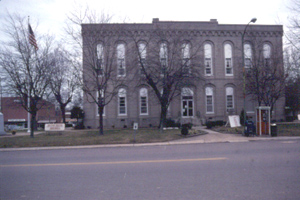
Crockett County
The desire for more convenient access to county government brought together the citizens of the outlying regions of Dyer, Gibson, Haywood, and Madison Counties to petition the Tennessee General Assembly for the formation of a new county first in 1832 and again, thirteen years later, in 1845. Both petitions were unsuccessful. In November 1871, though, the legislature finally provided relief for the isolated farmers by enacting legislation to form Crockett County, named for the famous Tennessean Davy Crockett. Appropriately, the county seat was named Alamo, after the historic mission in San Antonio, Texas, where Crockett died in 1836. Two commissioners from each county from which land was taken met to establish county government. The county courthouse, which was completed in 1874, continues to serve local needs.
The 265 square miles of Crockett County lying in the Mississippi River drainage area are covered with fertile farm land that has few hilly sections. Since no town has a population of over 2,500, the entire county is classified as rural. When the Tennessee Department of Agriculture established its Century Farms program in 1976, it identified eleven historic family farms, the oldest of which was the Frog Jump Farm that Dr. Samuel Oldham Sr. established with 1,500 acres in 1830. Cotton was Oldham’s primary crop, but other nineteenth-century farmers in Crockett County produced wheat, small grains, corn, and livestock. In the twentieth century several families turned to specialized cash crops. At the Hillcrest Farm, for instance, Columbus H. Conley managed fruit orchards, strawberry patches, and a honey bee yard while operating a sorghum mill. He also established the Bank of Alamo, and its classical-style brick building in the county seat has been listed on the National Register of Historic Places.
Cotton, however, remains “king” in Crockett County. In 1995 almost 89,000 acres were planted in cotton, followed by 10,000 acres of soybeans (an important twentieth-century introduction), 3,000 acres of corn, 2,500 acres of wheat, and 137 acres of sorghum. The county ranked second in the state in the number of acres planted in cotton, but boasted the highest yields per acre. In the mid-1990s, cotton gins operated in Gadsden, Mason Grove, Alamo, Bells, Cairo, Maury City, and Crockett Mills.
The success of agriculture in Crockett County is closely tied to the history of railroads. In 1858-59 the Memphis, Clarksville and Louisville Railroad built a line through the eastern half of what later became Crockett County. The presence of the tracks led to the creation of the new towns of Gasden, Fruitvale, and Bells. After the Louisville and Nashville Railroad assumed control of the earlier line in the mid-1870s, freight and passenger trains hummed through Crockett County on a daily basis. The train traffic encouraged the creation of cotton gins at towns along the line and also provided a ready market for the many perishable fruits being produced in the county during the early twentieth century. For many years the railroad town of Bells, rather than the county seat of Alamo, was the largest town in the county, even though its population only totaled 919 in 1940.
The African American community in Crockett County was one of the region’s more active participants in the Rosenwald school-building program. Blacks, with support from the fund and public sources, built one-room schools at Antioch, Cross Roads, and Fruitvale. Two-room schools were constructed at Hudson Grove and Maury City, while three-room schools were erected in Alamo, Bells, and Porter’s Grove. Overall, black residents of Crockett County raised almost twelve thousand dollars for the new schools.
A statistical atlas published in 1941 documents the rural quality of Crockett County during the first half of the twentieth century. The population was over 17,300 people, with African Americans comprising almost 20 percent of the population. In general, almost 85 percent of all adult males were engaged in agriculture, and 65 percent of farm operators were tenants. Few independent farm owners had survived the Great Depression; only 30 percent of white farm operators and 9.5 percent of black families actually owned their land. Crockett County farms were small, as well, averaging 45 acres in size across the county.
The population of Crockett County was 14,532 in 2000. The county includes five incorporated towns: Alamo, Bells, Friendship, Gadsden, and Maury City. According to 1998 figures, Alamo at 2,416 residents is the largest town. Bells is next, with 1,655 residents. In addition, a number of unincorporated communities including Fruitvale, Crockett Mills, Johnson Grove, Cairo, Walnut Hill, Perry’s Elizabeth, Old Field, Pond Creek, Lebanon, Jetton’s Mason Grove, and Coxville provide nearby residents the convenience of small stores and agricultural services. The county is governed by a county executive and twenty-four commissioners.
Several public recreation facilities enhance the lives of Crockett Countians. Residents can go fishing, boating, and picnicking at David Crockett Lake, which covers 87 acres in the eastern part of the county. Crockett Mills is host to the West Tennessee Cotton Festival held throughout the month of August, with varied events each weekend. A variety of civic and service clubs including a Chamber of Commerce, the Jaycees, Ruritan, Lions, and Rotary Clubs, and the Veterans of Foreign Wars offer opportunities for fellowship and community activities. Ninety-seven churches fill the religious needs of the county.



